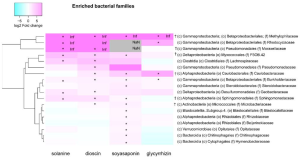A group from Research Institute for Sustainable Humanosphere, Kyoto University, Japan, etc. has reported that saponin treatments could control rhizobacteria.
https://www.ncbi.nlm.nih.gov/pmc/articles/PMC8538258/
Plant specialized metabolites (PSMs) secreted from roots are called root exudates, and these account for up to 40% of the carbon fixed during photosynthesis. Rhizosphere microbiomes assembled by root exudates promote plant growth and help the host plants overcome biotic and abiotic stresses. However, the association between PSMs and microbiota is not well characterized.
Saponins are a group of PSMs widely distributed in angiosperm plants. They exhibit biological and pharmacological activities, including antibacterial, antifungal, hemolytic, and cytotoxic properties.
Burkholderiaceae, Methylophilaceae, Rhodocyclaceae, Moraxellaceae, Pseudomonadaceae, P3OB-42, Caulobacteraceae, Steroidobacteraceae, Geobacteraceae, and Sphingomonadaceae were enriched in saponin (α-Solanin, dioscin, soyasaponins, and glycyrrhizin) treatments as shown below.
For instance, members of the family Burkholderiaceae are reportedly involved in plant–pathogen suppression via the upregulation of induced systemic resistance-associated genes and the production of sulfurous volatile compounds and siderophores, and members of Sphingomonadaceae have been found to promote plant growth via phytohormone production, alleviation of heavy metal toxicity and drought stress, and pathogen suppression.
Therefore, it is plausible that saponin-producing plants may benefit from attracting those bacterial families to their rhizospheres and roots.

